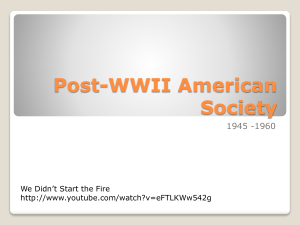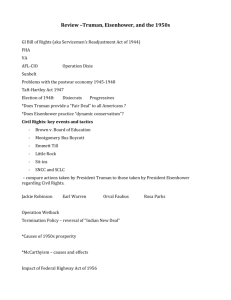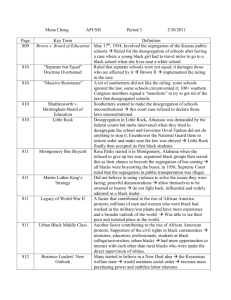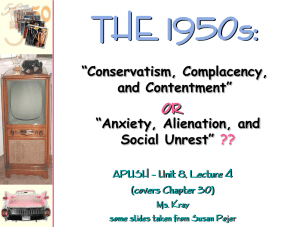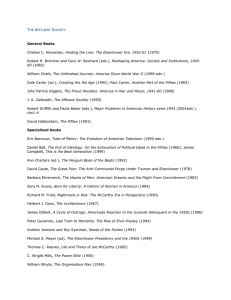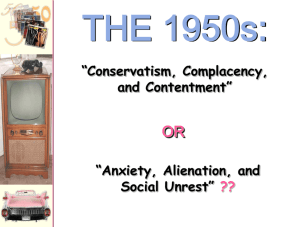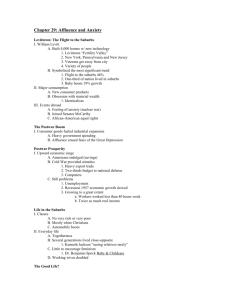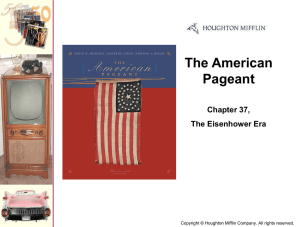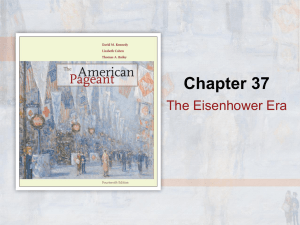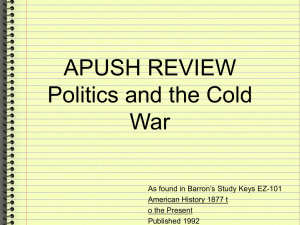Post-WWII American Society
advertisement
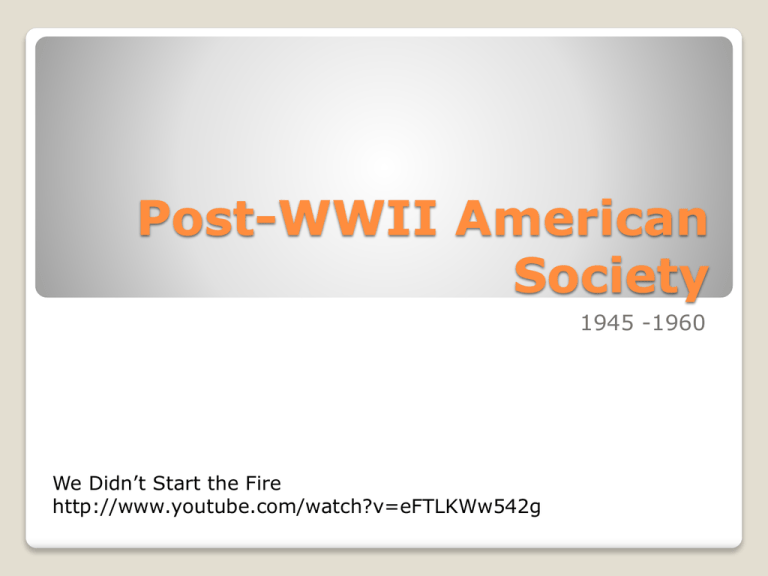
Post-WWII American Society 1945 -1960 We Didn’t Start the Fire http://www.youtube.com/watch?v=eFTLKWw542g Positives No economic collapse after WWII Americans had saved wages during war when their were no consumer goods $6 billion tax cut GI Bill of Rights provided education & economic assistance to veterans Negatives ◦ Inflation of 15% annually ◦ Labor strikes (UAW, AFL, UMW) –wages didn’t keep pace w/inflation ◦ Minorities & women replaced, but most wanted to keep working Move to service work (domestic & pink collar jobs) Reconversion Fair Deal ◦ ◦ ◦ ◦ Expansion of SS benefits Raise minimum wage Universal Healthcare Fair Employment Practices Act (FEPA) ◦ Public housing ◦ St. Lawrence Seaway ◦ Nationalization of atomic energy Election of 1948 Democrats split over civil rights ◦ Dixiecrats –southern whites Surprise win lets Truman revives Fair Deal ◦ SS expansion ◦ 75 cent minimum wage ◦ National Housing Act Republicans control Congress ◦ Defeated most measures ◦ Passed Taft-Hartley Act Right to work states ‘closed shops’ made illegal Truman’s domestic agenda Communism was NOT an imagined enemy of the 1950s ◦ Eastern Europe, Korea, Maoist Revolution Ethel & Julius Rosenberg ◦ Convicted & put to death for passing atomic weapon plan to the Soviets House un-American Activities Committee ◦ ‘Hollywood Ten’ ◦ Alger Hiss & Whitaker Chambers ◦ Congressman Richard M. Nixon ◦ https://www.youtube.com/watch?v=s6BfCbrvuM Crusade against subversion McCarran Internal Security Act, 1950 ◦ All communist orgs must register w/Feds ◦ J.Edgar Hoover & FBI investigate thousands of Federal employees McCarthyism ◦ Senator Eugene McCarthy + asst. Roy Cohn, 1950 ◦ Democrats accused of ‘20 years of treason’ ◦ Public hearings never produced evidence ◦ Ended w/McCarthyArmy hearings of 1954 Dwight D. Eisenhower chosen by Republicans in 1952: ◦ No political identification ◦ WWII hero, Pres. of Columbia University, commander of NATO ◦ No political skeletons ◦ Pledges to settle Korean Conflict Richard Nixon as vice-president ◦ the ‘communist crusader’ to pacify conservatives ◦ Early accusations of financial improprieties Checkers speech http://www.youtube.com/watch?v=I9LcAJOsFGg Republican Revival Conformity Consensus Reaction The Economic Miracle Economic boom of the 1950s was 250% more than the 20’s ◦ ◦ ◦ ◦ More evenly distributed in society Gov’t spending in schools, housing, veterans’ benefits Low inflation 3% annually Low unemployment less than 5% Nations population rose 20% from births ‘baby boom’ Interstate highway program, 1956 Increased military spending Rise of the Sunbelt ◦ Oil production ◦ Western state universities & research facilities Suburban living ◦ Surge in automobile ownership No competition outside of US ◦ home (new production) purchases ‘New Economics’ ◦ John Maynard Keynes part II ◦ To prevent recession –tax cuts to stimulate spending, thus economic growth Expansion of Science & Technology Medical Breakthroughs ◦ Penicillin & other Antibiotics Nearly eradicates tuberculosis in the US ◦ Salk Vaccine for Polio ◦ Thalidomide Pesticides ◦ DDT –controls insect-borne diseases, but long term toxic affect on people & animals Electronics ◦ Transistors –miniaturization of electronics ◦ Television –mass produced, affordable Computer technology ◦ UNIVAC –US Census; predict 1952 election ◦ IBM data processing for business & gov’t Bombs, Rockets & Missiles ◦ Hydrogen Bomb –fusion reaction; vastly more powerful ◦ Unmanned rockets for bomb delivery -ICBMs Space Program ◦ Satellites: Sputnik (1957USSR) vs. Explorer I (1958 – US) ◦ Manned space flight -Apollo program Consumer Culture Car Culture Fast Food Suburbs Nuclear family –two generation families Child-centered (child’s needs come first) TV’s homogenizing message ◦ Revolving charge accounts & credit cards ◦ Improved appliances & leisure time devices (radios, hi-fis, tvs) ◦ Plastic toys & entertainment inspired toys ◦ Suburbs ◦ Leisure time. Drive-ins, family vacations ◦ Garages, parking lots ◦ Levittown –working class homes ◦ white flight; minority population from WWII remains in Northern cities ◦ Gender roles reinforced (dad’s sphere –work) mom’s sphere –home) ◦ Dr. Benjamin Spock –purpose of motherhood was to raise & teach children ◦ Ideal American family, -white, middle-class, suburban ◦ Non-threatening urban & african-american shows Andy Griffith https://www.youtube.com/watch?v=I65zFT9h8Jk The Suburban Nation I saw the best minds of my generation destroyed by madness, starving hysterical naked, dragging themselves through the negro streets at dawn looking for an angry fix, angelheaded hipsters burning for the ancient heavenly connection to the starry dynamo in the machinery of night, who poverty and tatters and hollow-eyed and high sat up smoking in the supernatural darkness of cold-water flats floating across the tops of cities contemplating jazz, who bared their brains to Heaven under the El and saw Mohammedan angels staggering on tenement roofs illuminated, who passed through universities with radiant cool eyes hallucinating Arkansas and Blake-light tragedy among the scholars of war, who were expelled from the academies for crazy & publishing obscene odes on the windows of the skull.... Allen Ginsberg’s “Howl” Decline of the efficacy of values like restraint & thrift Rebellion to adult authority Beat generation (beatniks) –criticized the sterility of middle class life ◦ Jack Kerouac’s On the Road (1957) Road trip, glorification of rootlessness Rock n’ Roll –’the negro sound’ ◦ Drew heavily from black rhythm & blues music ◦ Music producers wanted white artists who would be able to play to white audiences Bill Haley’s Rock Around the Clock (1955) Buddy Holly (1955) Elvis Pressley (1956) Youth Culture Socialist writer Michael Harrington’s book ◦ In 1960, at least 1/5th of all families lived in poverty (30 mil) ◦ 20% of this group lived in persistent poverty Rise of inner-city “ghettos” Black Urban migration 1940-1960 Mexican & Puerto Rican immigration 1940-1960 ◦ Unskilled industrial jobs begin declining in the 1950s ◦ Created a “culture of poverty” as more middle class whites moved to suburbs ◦ Northern manufacturing jobs in WWII ◦ Result of mechanization of cotton harvesting The Other America Brown v. Board of Education of Topeka, KS, 1954 ◦ Washington, DC & Northern cities integration came quickly Whites launch “Massive Resistance” in the south Shuttlesworth V. Birmingham BOE, 1958 ◦ Scholastic ability & social behavior could not be used to maintain segregation Eisenhower administration did not want to commit themselves to desegregation, but finally had to: Little Rock Nine, 1957 Montgomery Bus Boycott, 1955 ◦ National Guard sent to enforce federal court order ◦ Rosa Parks ◦ Dr. Martin Luther King, Jr –civil disobedience ◦ Lasted 381 days Civil Rights Movement Eisenhower Foreign policy Federal Highway & Defense Act, 1956 ◦ 40,000 miles of interstate Secretary of State John Foster Dulles & Eisenhower direct foreign policy ◦ ‘massive retaliation’ policy, 1954 Nuclear weapons “more bang for the buck” ◦ Vietnam ◦ French tried reclaim control of colony after WWII against communist insurgency led by Ho Chi Min, 1954 ◦ Eisenhower would not support French army at Dien Bien Phu, 1954 ◦ Suez Crisis, 1956 US backed out of plan to co-build w/Egypt Aswan Dam across the Nile President Nasser seized Suez Canal from the British Israeli, British & French forces attacked US & other UN members pressured a truce w/Egypt ◦ Hungarian Revolution, 1956 –USSR put down democratic demonstrators ◦ U2 Crisis, 1959 –US spy plane is shot down over Soviet airspace Pilot Francis Gary Powers held hostage ◦ At end of 2nd term warned about too much influence in American foreign policy of a vast ‘military-industrial complex’ Eisenhower & the Cold War
